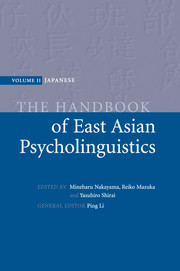Introduction
Published online by Cambridge University Press: 05 June 2012
Summary
This Introduction provides a brief discussion of the characteristics of both spoken and written Japanese that will serve as background knowledge for readers who are not very familiar with the language. At the same time, we refer to specific chapters in this volume that are pertinent to the linguistic aspects under question whenever possible.
Characteristics of Japanese
Spoken Japanese
Sound system Japanese is a mora-timed language with a pitch accent system. A mora is a subsyllabic unit that determines the weight of a syllable. A regular mora is also a syllable, which is either V or CV. In addition, there are three types of morae (called special morae), which are perceived as having the same length as regular morae by Japanese speakers although they do not constitute syllables, viz. moraic consonants (i.e. the first part of geminate consonants or a moraic nasal), e.g. /Q/ in /kaQta/, /N/ in /hoN/, or the second half of a long vowel or a diphthong, e.g. /R/ of /keRki/. One mora also corresponds to one kana character in writing (see the section on written Japanese below). Unlike English, a language with a stress accent system, Japanese lexical accent is based on pitch, high vs. low, as shown below:
(1) a. ame “rain” (HL)
b. ame “candy” (LH)
The accents shown above are those of the Tokyo dialect. These accents do not change in speech within a dialect (e.g. they are not affected by intonation).
- Type
- Chapter
- Information
- The Handbook of East Asian Psycholinguistics , pp. 1 - 10Publisher: Cambridge University PressPrint publication year: 2006



